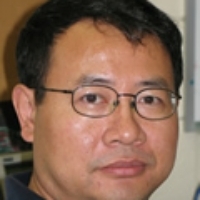De-Tong Jiang

Associate Professor
College of Engineering and Physical Sciences
Department of Physics
Guelph, Ontario
detong@physics.uoguelph.ca
Office:
(519) 824-4120 ext. 53982
Bio/Research
Dr. Jiang's current research involves four aspects: 1) growth and structural property studies of organic semiconductor films; 2) structural properties of nickel silicide thin films; 3) arsenic speciation in environmentally important systems; and 4) structural properties of materials under extreme...
Click to Expand >>
Click to Expand >>
Bio/Research
Dr. Jiang's current research involves four aspects: 1) growth and structural property studies of organic semiconductor films; 2) structural properties of nickel silicide thin films; 3) arsenic speciation in environmentally important systems; and 4) structural properties of materials under extreme conditions. The common theme is applying a multitude of synchrotron radiation-based techniques to probe the atomic/molecular structures for understanding the structure-function relationships and in some cases for acquiring the atomic/molecular level control of complex structures.
In his first research area, Jiang focuses on polyacene semiconductor thin films. Three projects are underway: a) in situ and ex-situ carbon 1s polarization-dependent NEXAFS studies on the tetracene and pentacene growth mechanisms on various solid substrates; b) gas-phase NEXAFS of the polyaromatic molecules and theoretical simulation (StoBe code); and c) ex-situ grazing-incidence X-ray diffraction (GIXD) study on the thickness dependence of the epitaxial structures of tetracene on reduced silicon surfaces. The polyacene thin-film NEXAFS and GIXD projects are in collaboration with the Qin group (U of G). Systems studied include tetracene and pentacene on H/Si(001) (wet chemistry method) and SiO2 substrates, and tetracene on flat and specific terraced H/Si(001) substrates. The polyacene gas-phase project aims at developing a thorough understanding of the C 1s near-edge X-ray absorption spectroscopy of these molecules for application as a structural tool in studying the polyacene semiconductor films.
For his second research area, Jiang is collaborating with Lavoie’s group (IBM, Yorktown Heights) to investigate the XANES and XAFS signatures of the industrial nickel silicide layers targeted for new generations of nanoscale electronic applications. Recently they have demonstrated that the method they're developing is capable of identifying the epitaxial phase of an interface region with a thickness of 1-3 nm, where conventional diffraction methods have not been effective.
Jiang carred out his third research area with with N. Chen (CLS), G. Demopoulos (McGill), and J. Rowson (AREVA Res., Canada), and S. Glasauer (Dept. of Land Resource Sci., U of Guelph) and studied asenic speciation using XAFS endstation at CLS HXMA beamline. In these studies, they have systematically studied the pH, temperature, and aging time factors in the formation of the scorodite phase under the geochemical conditions mimicking that at uranium mine tailing process facilities.
Jiang's fourth research area involves the study of materials under extreme conditions involves diffraction and XAFS studies under a high-pressure environment generated with diamond anvil cells (DAC) (J. Tse/U of S, S. Desgreniers/U Ottawa, D. Klug/NRC, N. Chen and C.Y. Kim/CLS), aimed at the fundamental structural and electronic properties of materials under high pressure.
A new research project is in progress which will invoke x-ray absorption spectroscopy studies on material electronic structures under high pressure.
Click to Shrink <<
In his first research area, Jiang focuses on polyacene semiconductor thin films. Three projects are underway: a) in situ and ex-situ carbon 1s polarization-dependent NEXAFS studies on the tetracene and pentacene growth mechanisms on various solid substrates; b) gas-phase NEXAFS of the polyaromatic molecules and theoretical simulation (StoBe code); and c) ex-situ grazing-incidence X-ray diffraction (GIXD) study on the thickness dependence of the epitaxial structures of tetracene on reduced silicon surfaces. The polyacene thin-film NEXAFS and GIXD projects are in collaboration with the Qin group (U of G). Systems studied include tetracene and pentacene on H/Si(001) (wet chemistry method) and SiO2 substrates, and tetracene on flat and specific terraced H/Si(001) substrates. The polyacene gas-phase project aims at developing a thorough understanding of the C 1s near-edge X-ray absorption spectroscopy of these molecules for application as a structural tool in studying the polyacene semiconductor films.
For his second research area, Jiang is collaborating with Lavoie’s group (IBM, Yorktown Heights) to investigate the XANES and XAFS signatures of the industrial nickel silicide layers targeted for new generations of nanoscale electronic applications. Recently they have demonstrated that the method they're developing is capable of identifying the epitaxial phase of an interface region with a thickness of 1-3 nm, where conventional diffraction methods have not been effective.
Jiang carred out his third research area with with N. Chen (CLS), G. Demopoulos (McGill), and J. Rowson (AREVA Res., Canada), and S. Glasauer (Dept. of Land Resource Sci., U of Guelph) and studied asenic speciation using XAFS endstation at CLS HXMA beamline. In these studies, they have systematically studied the pH, temperature, and aging time factors in the formation of the scorodite phase under the geochemical conditions mimicking that at uranium mine tailing process facilities.
Jiang's fourth research area involves the study of materials under extreme conditions involves diffraction and XAFS studies under a high-pressure environment generated with diamond anvil cells (DAC) (J. Tse/U of S, S. Desgreniers/U Ottawa, D. Klug/NRC, N. Chen and C.Y. Kim/CLS), aimed at the fundamental structural and electronic properties of materials under high pressure.
A new research project is in progress which will invoke x-ray absorption spectroscopy studies on material electronic structures under high pressure.
Click to Shrink <<